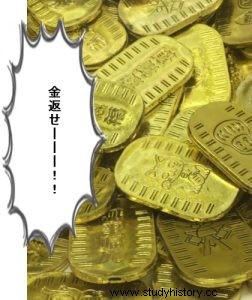" Abolition of the feudal clan The word is famous, isn't it?
The meaning remains the same as a four-character idiom.
"Abolish the clan and set up a prefecture" is.
This is one of the policies that the government implemented during the Meiji era, and I would like to introduce in detail what the intention was and why it was implemented.
Wasn't the "han" used in the Edo period in the first place?

Currently, the Satsuma domain and the Choshu domain are usually called with the "clan", but in the Edo period, no one officially called them.
The words "○○ clan", its lord "lord", and its vassal "hanshi" are modern historical terms.
I don't know in detail what people at that time actually called.
By the way, the word "shogunate" came to be used from the latter half of the Edo period.
The words "Kamakura Shogunate" and "Muromachi Shogunate" were not used either.
The reason why the abolition of the feudal clan was held!

Repatriation of version
" Taisei Hokan Then the Edo Shogunate disappeared and the government was returned to the emperor.
" Restoration Established the new Meiji government.
" Boshin War " If the new government army wins, the whole of Japan will become the territory of the new government.
However, as in the Edo period, each region was still governed by a daimyo.
Japan will have to stop the isolation and open the country and look to the world.
Therefore, we will set up a national system centered on the emperor to become one.
First, the territory "version" and the territory "register" of each daimyo were returned to the emperor.
This means that the land and people of Japan belong to the emperor.
This is Meiji 2 " Repatriation of version " is.
However, the feudal lord "chief lord" The name has just changed, and the rulers of each territory haven't changed. It hasn't changed much from the Edo period.
By the way, the word "han" began to be used around this time.
Abolition of the feudal clan
"Prefectures" and "prefectures" were placed under the direct control of the new government, but they were still about a quarter of the whole country.
Other than that, the "clan" ruled, so " Fuhanken Sanchisei " That's the state.
However, the central government "Governor" for prefectures and prefectures. "Chinese prefectural affairs" Was dispatched, but the clan was a former feudal lord "chief clan" It was extremely difficult for Japan to become one.
So, Meiji 4 In the Meiji government, the governors gathered at the Imperial Palace in Tokyo "Abolition of the Clan" I ordered.
The domain will disappear, and the domain governors will also be unemployed.
As expected, the former domain governors are " Kazoku ". It became the aristocratic class.
Actually, the word "han" was used for about two years.
How many prefectures and prefectures are there?
At first, the clan was replaced with the prefecture as it was, so "3 prefectures 302 prefectures" There were a number of things.
However, at this rate, there were many "funnels" where part of the land was separated from other places, and the unity was weak. In addition, from the following year onward, it merged with 69 prefectures, 60 prefectures, 59 prefectures, and 35 prefectures.
Then, the problem that the area was too large emerged, Meiji 22 . Currently "3 prefectures 43 prefectures" have become.
Clan problem!

Abolition of the feudal clan is a policy that has changed the way the lord governs the territory for a long time since the Heian period, and is the greatest reform in the Meiji Restoration . It is said that. It was such a big incident ...
However, not only the good things, but all the debts of the old clan became the responsibility of the new government.
Each clan had already had financial difficulties since the middle of the Edo period, and the clan's finances were in a state of fire due to the arrival of Kurofune at the end of the Edo period and the dispatch of troops to the Boshin War.
Before the abolition of the feudal clan, some clan volunteered to return their territory.
"Daimyo-gyo" from merchants in Osaka There was also a clan that was in debt, but it was in a state of bad debt, and the merchants were forced into bankruptcy.
Osaka, which had many merchants, was hit hard economically and fell from the center of the Japanese economy.
